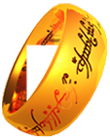Things of Middle-earth
Dagor Dagorath
Type: Songs & Stories
Other Names:
the Last Battle
the Second Prophecy of Mandos
the Day of Doom
the End
the full-making
the Great End
the Change of the World
Description:
The Last Battle with Melkor (Morgoth) that is said will occur at the end of Arda, after which it will be remade:
Manwë will not descend from the Mountain until Dagor Dagorath, and the coming of the End, when Melkor returns. 1
Unfinished Tales, Part 4, Ch 2, The Istari
Then shall the last battle be gathered on the fields of Valinor. In that day Tulkas shall strive with Melko, 2 and on his right shall stand Fionwë 2 and on his left Túrin Turambar, son of Húrin, Conqueror of Fate, coming from the halls of Mandos; and it shall be the black sword of Túrin that deals unto Melko his death and final end; and so shall the children of Húrin and all Men be avenged.
Morgoth's Ring, HoME Vol 10, Part 2, The Annals of Aman: Commentary on the second section of the Annals of Aman
[Many] other of the ancient stars [Varda] gathered together and set as signs in the heavens of Arda: Wilwarin, Telumendil, Soronúmë, and Anarríma; and Menelmacar with his shining belt, that forebodes the Last Battle that shall be at the end of days. And high in the north as a challenge to Melkor she set the crown of seven mighty stars to swing, Valacirca, the Sickle of the Valar and sign of doom.
The Silmarillion, Quenta Silmarillion, Ch 3, Of The Coming of the Elves and the Captivity of Melkor
... Menelmakar, 2 the Swordsman of the Sky..., it is said, was a sign of Túrin Turambar, who should come into the world, and a foreshowing of the Last Battle that shall be at the end of Days.
Morgoth's Ring, HoME Vol 10, Part 2, The Annals of Aman
[Menelmacar] has diamonds on his sword-sheath, and this will go red when he draws his sword at the Great End.
The Book of Lost Tales 2, HoME Vol 2, Ch 6, The History of Eriol or Ælfwine and the End of the Tales
'But behold!' said [Ulmo], 'in the armour of Fate (as the Children of Earth name it) there is ever a rift, and in the walls of Doom a breach, until the full-making, which ye call the End.'
Unfinished Tales, Part 1, Ch 1, Of Tuor and His Coming to Gondolin
Will thou learn the lore / that was long secret
of the Five that came / from a far country?
One only returned. / Others never again
under Men's dominion / Middle-earth shall seek
until Dagor Dagorath / and the Doom cometh.
Unfinished Tales, Part 4, Ch 2, The Istari
And all the fleets of the Númenóreans were drawn down into the abyss.... But Ar-Pharazôn the King and the mortal warriors that had set foot upon the land of Aman were buried under falling hills: there it is said that they lie imprisoned in the Caves of the Forgotten, until the Last Battle and the Day of Doom.
The Silmarillion, Akallabêth
As three great Jewels [the Silmarils] were in form. But not until the End, when Fëanor shall return who perished ere the Sun was made, and sits now in the Halls of Awaiting and comes no more among his kin; not until the Sun passes and the Moon falls, shall it be known of what substance they were made.
The Silmarillion, Quenta Silmarillion, Ch 7, Of the Silmarils and the Unrest of the Noldor
Never since have the Ainur made any music like to this music, though it has been said that a greater still shall be made before Ilúvatar by the choirs of the Ainur and the Children of Ilúvatar after the end of days. Then the themes of Ilúvatar shall be played aright, and take Being in the moment of their utterance, for all shall then understand fully his intent in their part, and each shall know the comprehension of each, and Ilúvatar shall give to their thoughts the secret fire, being well pleased.
The Silmarillion, Ainulindalë
For [the Dwarves] say that Aulë the Maker, whom they call Mahal, cares for them, and gathers them to Mandos in halls set apart; and that he declared to their Fathers of old that Ilúvatar will hallow them and give them a place among the Children in the End. Then their part shall be to serve Aulë and to aid him in the remaking of Arda after the Last Battle.
The Silmarillion, Quenta Silmarillion, Ch 2, Of Aulë and Yavanna
This legendarium ends with a vision of the end of the world, its breaking and remaking, and the recovery of the Silmarilli and the 'light before the Sun' — after a final battle which owes, I suppose, more to the Norse vision of Ragnarök 3 than to anything else, though it is not much like it.
The Letters of J. R. R. Tolkien, Edited by Humphrey Carpenter, Letter 131 to Milton Waldman
Notes
1 This is a reference to "the Second Prophecy of Mandos," which does not appear in The Silmarillion....
Unfinished Tales, Part 4, Ch 2, The Istari: Notes, Note 8
2 This text is from one of Tolkien's early drafts; the name is an earlier version of the proper name as published in The Silmarillion.
3 In Norse mythology, Ragnarök.... is a series of future events, including a great battle foretold to ultimately result in the death of a number of major figures (including the gods Odin, Thor, Týr, Freyr, Heimdallr, and Loki), the occurrence of various natural disasters, and the subsequent submersion of the world in water. Afterward, the world will resurface anew and fertile, the surviving and reborn gods will meet, and the world will be repopulated by two human survivors.
"Ragnarök". Wikipedia, the free encyclopedia. 22 Jan. 2012.
<Wikipedia.org en.wikipedia.org/wiki/Ragnar%C3%B6k>.
Contributors:
Elena Tiriel 10Oct07, 22Jan12
